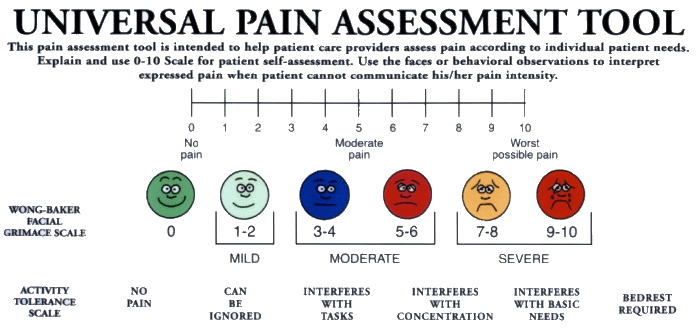Pain Control
Your nurse may teach you how to use the pain scale below or a similar scale to describe your level of pain after your surgery. In its simplest form, “0” is no pain and “10” is the worst possible pain.

Source: From Hockenberry MJ, Wison D, Wilkelstein ML: Wong's Essentials of Pediatric Nursing, ed 7, St. Louis, 2005, p.1259. Used with permission. Copyright, Mosby.
Our goal is to keep your pain at “3-4” or below.
Pills
If your pain isn’t too severe, taking pills (oral medication) every few hours may be enough to control your pain. Your doctor will prescribe a drug and a dose based on your overall health and level of pain.
You will likely use a combination of pills to control your pain after surgery.
Injections
You may be given a dose of pain-relieving medication by needle (injection), which goes directly into the muscle of your arm, leg or buttock. It could take as long as one hour before you feel the pain-relieving effect.
It is very important to get into a schedule of taking your pain medications one hour before doing your exercises.
Patient controlled analgesia (PCA) pump
If you have had a general anesthetic, you may also have a self-controlled analgesia (PCA) pump. This pump allows you to give yourself a controlled amount of pain medication through your IV tube when you push a button.
Pain, Pain, Go Away!
No two people are exactly alike when it comes to pain. Some people can withstand pain with ease, while others are much more sensitive to pain. You will experience some pain when your operation is over, but there are several ways to control it.
NOTE: It is NOT a good idea to "tough it out" after surgery and refuse medications to ease your pain.
Ask your nurse for pain medication.
Research shows that patients who ask for and receive pain medication actually do better during their rehabilitation. That's because if you are in pain, it may be harder for your therapist to help you get moving. Pain can also make you feel nervous or upset and make you afraid to do the exercises you need to recover. It is important to ask for medications when you are in pain.
Side Effects
Some side effects of pain medicine can include: nausea, vomiting, drowsiness, itchiness and/or constipation. Make sure to tell your nurse if you have any of these symptoms.
About constipation
After surgery, many patients develop symptoms of constipation that can make them feel very uncomfortable. One reason for this is that many painkillers cause constipation as a side effect. Being inactive can also lead to constipation. If you have trouble moving your bowels after surgery, tell your nurse – they can help you!